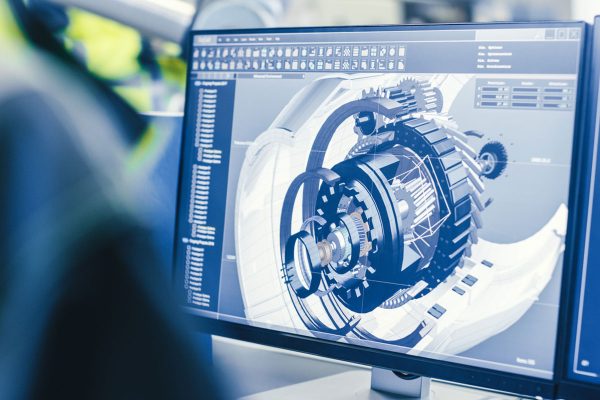From Concept to Reality
The shift from two-dimensional drafting to three-dimensional design has revolutionized engineering and manufacturing. Today, 3D designs and simulation technologies allow engineers to visualize, analyse, and optimize complex systems before they’re ever built. This not only speeds up product development but also reduces risk, cost, and downtime. In industrial settings—from factory layouts to robotic cells—3D design tools are now essential for turning concepts into efficient, real-world solutions.
What Is 3D Design in Industry?
3D design refers to the process of creating digital, three-dimensional representations of physical objects, systems, or environments. These models are built using Computer-Aided Design (CAD) software and can represent anything from a single machine part to an entire production line.
Engineers use 3D models to:
- Visualize spatial relationships and component fit
- Identify design flaws or interference
- Generate detailed manufacturing drawings
- Create photorealistic renders and animations
- Share designs across teams and departments
Modern CAD platforms support parametric modelling, which allows for changes in one component to automatically update linked parts—critical in complex assemblies.

What Is Simulation in Engineering?
Simulation involves using digital models to predict how a product, system, or process will perform under various real-world conditions. Simulation tools use physics-based algorithms to analyze factors like stress, heat, motion, fluid flow, and system dynamics.
Common simulation types include:
- Finite Element Analysis (FEA) for structural integrity
- Computational Fluid Dynamics (CFD) for airflow and fluid movement
- Discrete Event Simulation for process optimization
- Kinematic simulations for motion and collision detection
By simulating behavior before building, engineers can reduce prototyping cycles and make data-driven design decisions.
The Impact of 3D Design and Simulation on Industry
The combination of 3D modeling and simulation has led to significant gains in quality, efficiency, and innovation across engineering disciplines.
Accelerated Development Cycles
Designing in 3D enables rapid prototyping—engineers can go from concept to functional prototype in a fraction of the time compared to traditional methods. With simulation, virtual testing replaces many rounds of physical iteration. This is especially useful in industries with fast-paced product lifecycles such as electronics, consumer goods, and automotive.
Improved Accuracy and Quality
Digital models allow for precise measurement, alignment, and tolerance analysis before fabrication begins. Engineers can detect clashes between components, incorrect dimensions, or inconsistent materials early in the design process. Simulations further verify performance under operational loads, stresses, or environmental conditions, reducing the chance of failure after deployment.
Reduced Material Waste and Costs
Simulations enable optimization of material usage, component geometry, and structural design. For example, topology optimization algorithms can remove unnecessary mass from parts without compromising strength. This leads to cost savings in raw materials and machining time, especially in industries where lightweighting is crucial.
Enhanced Communication and Collaboration
3D models and simulation results can be easily shared across teams, suppliers, and stakeholders. Interactive visualizations make it easier to communicate design intent, evaluate alternatives, and make faster decisions. Engineers can collaborate remotely, annotate models in real time, and version-control changes—streamlining the entire workflow.
Virtual Commissioning
In industrial automation, 3D simulation plays a crucial role in validating machine behavior before hardware is installed. Virtual commissioning involves simulating entire production lines, robotic arms, or conveyor systems in a digital twin environment. Engineers can test logic, sequences, and safety interactions before the physical build, greatly reducing commissioning time on site.
Safer, Smarter Systems
Simulations help engineers identify failure modes, thermal hotspots, stress concentrations, and ergonomic risks. In manufacturing or plant design, simulating human interactions and movement through a 3D model can improve safety, efficiency, and space utilization. For example, layouts can be adjusted to improve operator access, reduce travel distances, or ensure compliance with regulations.
Integration With Emerging Technologies
3D design and simulation are increasingly linked with other cutting-edge technologies:
- Digital Twins: Real-time synchronization of physical and digital systems
- Additive Manufacturing: Direct-to-print workflows from optimized 3D models
- AR/VR: Immersive visualization of factories or products before construction
- IoT Data Feedback: Real-world performance data looped back into simulations
These integrations are driving smarter, more connected industrial ecosystems.
Key Tools and Software Platforms
A wide range of tools exist for 3D design and simulation, including:
- CAD Software: SolidWorks, Autodesk Inventor, Siemens NX, PTC Creo
- Simulation Software: ANSYS, COMSOL, SimScale, Dassault Systèmes
- Process Simulation: FlexSim, Tecnomatix, AnyLogic
- Plant Design Tools: AutoCAD Plant 3D, Factory Design Utilities
Selection depends on the complexity of the project, the physical domain (mechanical, thermal, fluid, etc.), and integration needs.
Real-World Applications
- Factory Layout Planning: Create efficient plant layouts and optimize space usage
- Robotic Workcells: Simulate reach, timing, and collision detection for robotic arms
- Mechanical Design: Analyze load paths and stress on custom machine components
- HVAC Systems: Model airflow and temperature gradients in building systems
- Packaging Equipment: Validate machine timing, sequence, and product handling
These applications show the breadth of impact across industries ranging from manufacturing and construction to logistics and energy.
The Future of 3D Design and Simulation
As processing power increases and cloud-based platforms expand, 3D design and simulation will become more accessible and powerful. Engineers will be able to simulate full factories with real-time physics, AI-driven optimization, and automatic design suggestions.
Expect:
- Simulation results integrated live into design models
- AI-assisted design based on thousands of prior iterations
- Autonomous systems that learn and adapt from simulations
- Broader use of simulation in smaller companies via SaaS models
This evolution will blur the line between physical and digital, enabling a more iterative, experimental, and intelligent approach to engineering.
3D design and simulation are no longer niche tools—they’re essential pillars of modern engineering and industrial planning. By visualizing systems in three dimensions and predicting performance before physical production, companies can innovate faster, reduce risk, and achieve higher precision. As industries continue to evolve, mastering these tools will be critical for staying agile, efficient, and competitive.
